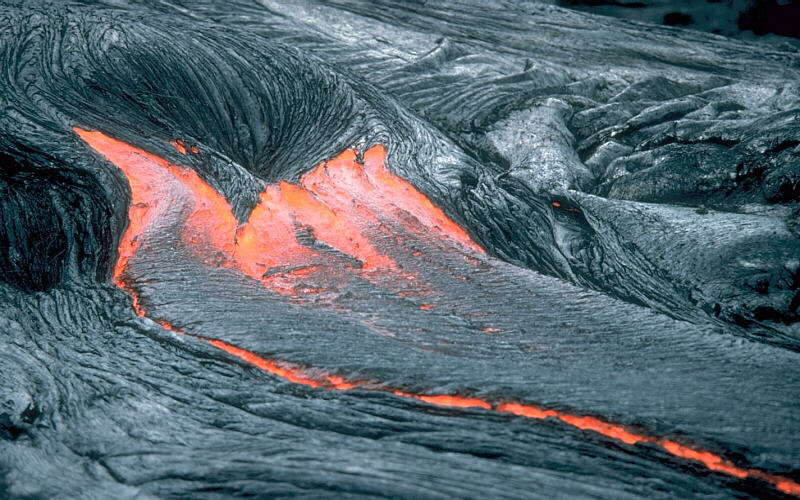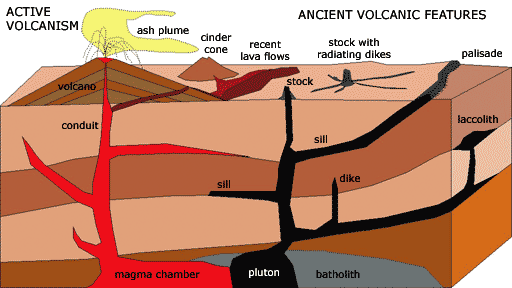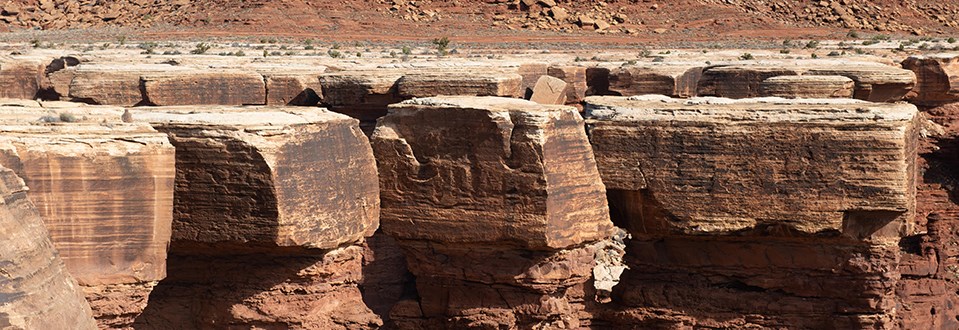9 Planet Earth
The goals and objectives of this chapter are to:
- Describe Earth as a planetary body.
- Explain the various motions of Earth and the results of those motions.
- Compare continental and oceanic features on the surface of the Earth.
- Describe the three major types of rock features and how the rock cycle describes their creation.
Earth as a Planetary Body
EARTH’S SHAPE
Earth is an inner planet in the solar system and it is very much like the other inner planets, at least in its size, shape, and composition. But many features make Earth very different from the planets and any other planet that we know of so far. Earth is a sphere or, more correctly, an oblate spheroid, which is a sphere that is a bit squished down at the poles and bulges a bit at the equator. Or to be more technical, the minor axis (the diameter through the poles) is smaller than the major axis (the diameter through the equator). When the earth is cut in equal halves, each half is called a hemisphere. North of the equator is the northern hemisphere and south of the equator is the southern hemisphere. Eastern and western hemispheres are also designated. What evidence is there that Earth is spherical? What evidence was there before spaceships and satellites? Try to design an experiment involving a ship and the ocean to show Earth is round. If you are standing on the shore and a ship is going out to sea, the ship gets smaller as it moves further away from you but the ship’s bottom also starts to disappear as the vessel goes around the arc of the planet. There are many other ways that early scientists and mariners knew that Earth was not flat.Even the ancient Greeks knew that Earth was round by observing the arc shape of the shadow on the Moon during a lunar eclipse. The Sun and the other planets of the solar system are also spherical. Larger satellites, those that have enough mass for their gravitational attraction to have made them round, are as well.
Earth’s Motions

EARTH’S ROTATION
Imagine a line passing through the center of Earth that goes through both the North Pole and the South Pole. This imaginary line is called an axis. Earth spins around its axis, just as a top spins around its spindle. This spinning movement is called Earth’s rotation. At the same time that the Earth spins on its axis, it also orbits, or revolves around the Sun. This movement is called revolution. A pendulum set in motion will not change its motion, and so the direction of its swinging should not change. However, Foucault observed that his pendulum did seem to change direction. Since he knew that the pendulum could not change its motion, he concluded that the Earth, underneath the pendulum was moving. An observer in space will see that Earth requires 23 hours, 56 minutes, and 4 seconds to make one complete rotation on its axis. But because Earth moves around the Sun at the same time that it is rotating, the planet must turn just a little bit more to reach the same place relative to the Sun. Hence the length of a day on Earth is actually 24 hours.
EARTH’S REVOLUTION
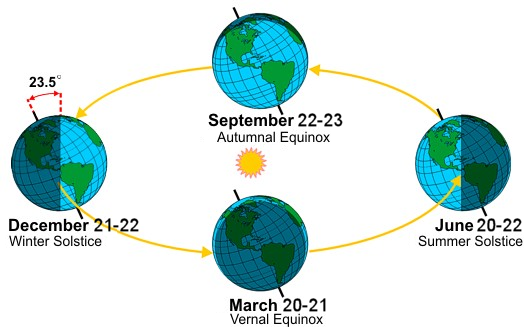
For Earth to make one complete revolution around the Sun takes 365.24 days. This amount of time is the definition of one year. The gravitational pull of the Sun keeps Earth and the other planets in orbit around the star. Like the other planets, Earth’s orbital path is an ellipse so the planet is sometimes farther away from the Sun than at other times. The closest Earth gets to the Sun each year is at perihelion (147 million km) on about January 3rd and the furthest is at aphelion (152 million km) on July 4th. Earth’s elliptical orbit has nothing to do with Earth’s seasons. During one revolution around the Sun, Earth travels at an average distance of about 150 million km. Earth revolves around the Sun at an average speed of about 27 km (17 mi) per second, but the speed is not constant. The planet moves slower when it is at aphelion and faster when it is at perihelion. The reason the Earth (or any planet) has seasons is that Earth is tilted 23 1/2° on its axis. During the Northern Hemisphere summer the North Pole points toward the Sun, and in the Northern Hemisphere winter the North Pole is tilted away from the Sun.
Earth’s Surface Features
Earth’s surface features are the result of constructive and destructive forces. Constructive forces cause landforms to grow. The eruption of a new volcano creates a new landform. Destructive forces wear landforms down. The slow processes of mechanical and chemical weathering and erosion work over time to change once high mountains into smooth flat plateaus.
- The continents are large land areas extending from high mountaintops to sea level.
- The ocean basins extend from the edges of the continents down steep slopes to the ocean floor and into deep trenches.
CONTINENTS
The oldest continental rocks are billions of years old, so the continents have had a lot of time for things to happen to them. Constructive forces cause physical features on Earth’s surface known as landforms to grow. Crustal deformation – when crust compresses, pulls apart, or slides past other crust – results in hills, valleys, and other landforms. Mountains rise when continents collide, when one slab of ocean crust plunges beneath another or a slab of continental crust to create a chain of volcanoes. Sediments are deposited to form landforms, such as deltas.
Volcanic eruptions can also be destructive forces that blow landforms apart. The destructive forces of weathering and erosion modify landforms. Water, wind, ice, and gravity are important forces of erosion. This scene is within the East African Rift where the crust is being pulled apart to form a large valley.
- Which features result from constructive forces? Volcanoes have been constructed within the valley by rising magma.
- Which features result from destructive forces? Volcanic explosions or collapses have destroyed volcanic mountains to form craters. Fractures caused by the rifting in the valley are signs that the valley is breaking apart. Streams are eroding downward into the slopes of the volcanoes. Landslides erode the steep volcanoes. A landslide scar is seen on left side of the small, very steep volcanic cone near the center of the image, and landslide deposits have traveled outward from the scar.
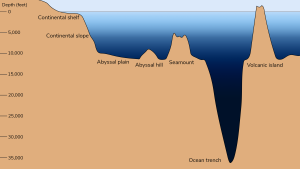
OCEAN BASINS
The ocean basins are all younger than 180 million years. Although the ocean basins begin where the ocean meets the land, the continent extends downward to the seafloor, so the continental margin is made of continental crust. The ocean floor itself is not totally flat. The most distinctive feature is the mountain range that runs through much of the ocean basin, known as the mid-ocean ridge. The deepest places of the ocean are the ocean trenches, many of which are located around the edge of the Pacific Ocean. Chains of volcanoes are also found in the center of the oceans, such as in the area of Hawaii. Flat plains are found on the ocean floor with their features covered by mud.
CHANGING EARTH
Earth’s surface changes over short and long periods of time. Constructive forces cause new features to form by volcanic activity or uplift of the crust. Existing landforms are modified by destructive forces, perhaps even eroded away by water, wind, ice, and gravity. Beneath the oceans, volcanic activity forms new seafloor while old seafloor is destroyed at the trenches.
Defining Rock Types
There are three types of rocks: igneous, sedimentary and metamorphic. Each of these types is part of the rock cycle. Through changes in conditions one rock type can become another rock type. Or it can become a different rock of the same type. A rock is a naturally formed, non-living earth material. Rocks are made of collections of mineral grains that are held together in a firm, solid mass. How is a rock different from a mineral? Rocks are made of minerals. The mineral grains in a rock may be so tiny that you can only see them with a microscope, or they may be as big as your fingernail or even your finger. Rocks are identified primarily by the minerals they contain and by their texture. Each type of rock has a distinctive set of minerals. A rock may be made of grains of all one mineral type, such as quartzite. Much more commonly, rocks are made of a mixture of different minerals. Texture is a description of the size, shape, and arrangement of mineral grains.
Rocks are classified into three major groups according to how they form. Rocks can be studied in hand samples that can be moved from their original location. Rocks can also be studied in outcrop, exposed rock formations that are attached to the ground, at the location where they are found.
Igneous rocks form from cooling magma. Magma that erupts onto Earth’s surface is lava. The chemical composition of the magma and the rate at which it cools determine what rock forms as the minerals cool and crystallize. Sedimentary rocks form by the compaction and cementing together of sediments, broken pieces of rock-like gravel, sand, silt, or clay. Those sediments can be formed from the weathering and erosion of preexisting rocks. Sedimentary rocks also include chemical precipitates, the solid materials left behind after a liquid evaporates. Metamorphic rocks form when the minerals in an existing rock are changed by heat or pressure within the Earth.
The Rock Cycle
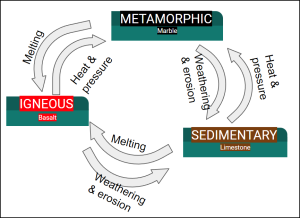
Rocks change as a result of natural processes that are taking place all the time. Most changes happen very slowly; many take place below the Earth’s surface, so we may not even notice the changes. Although we may not see the changes, the physical and chemical properties of rocks are constantly changing in a natural, never-ending cycle called the rock cycle. The concept of the rock cycle was first developed by James Hutton, an eighteenth century scientist often called the “Father of Geology.” Hutton recognized that geologic processes have “no [sign] of a beginning, and no prospect of an end.” The processes involved in the rock cycle often take place over millions of years. So on the scale of a human lifetime, rocks appear to be “rock solid” and unchanging, but in the longer term, change is always taking place. In the rock cycle the three main rock types are igneous, sedimentary, and metamorphic. Arrows connecting the three rock types show the processes that change one rock type into another. The cycle has no beginning and no end. Rocks deep within the Earth are right now becoming other types of rocks. Rocks at the surface are lying in place before they are next exposed to a process that will change them.
Several processes can turn one type of rock into another type of rock. The key processes of the rock cycle are crystallization, erosion and sedimentation, and metamorphism.
CRYSTALLIZATION
Magma cools either underground or on the surface and hardens into an igneous rock. As the magma cools, different crystals form at different temperatures, undergoing crystallization. For example, the mineral olivine crystallizes out of magma at much higher temperatures than quartz. The rate of cooling determines how much time the crystals will have to form. Slow cooling produces larger crystals.
EROSION AND SEDIMENTATION
Weathering wears rocks at the Earth’s surface down into smaller pieces. The small fragments are called sediments. Running water, ice, and gravity all transport these sediments from one place to another by erosion. During sedimentation, the sediments are laid down or deposited. In order to form a sedimentary rock, the accumulated sediment must become compacted and cemented together.
When a rock is exposed to extreme heat and pressure within the Earth but does not melt, the rock becomes metamorphosed. Metamorphism may change the mineral composition and the texture of the rock. For that reason, a metamorphic rock may have a new mineral composition and/or texture.
Igneous Rock
Igneous rocks form from the cooling and hardening of molten magma in many different environments. These rocks are identified by their composition and texture. More than 700 different types of igneous rocks are known.
MAGMA COMPOSITION
The rock beneath the Earth’s surface is sometimes heated to high enough temperatures that it melts to create magma. Different magmas have different composition and contain whatever elements were in the rock that melted. Magmas also contain gases. The main elements are the same as the elements found in the crust. Whether rock melts to create magma depends on:
- Temperature: Temperature increases with depth, so melting is more likely to occur at greater depths.
- Pressure: Pressure increases with depth, but increased pressure raises the melting temperature, so melting is less likely to occur at higher pressures.
- Water: The addition of water changes the melting point of rock. As the amount of water increases, the melting point decreases.
- Rock composition: Minerals melt at different temperatures, so the temperature must be high enough to melt at least some minerals in the rock. The first mineral to melt from a rock will be quartz (if present) and the last will be olivine (if present).
The different geologic settings that produce varying conditions under which rocks melt will be discussed in the “Plate Tectonics” chapter. As a rock heats up, the minerals that melt at the lowest temperatures will melt first. Partial melting occurs when the temperature on a rock is high enough to melt only some of the minerals in the rock. The minerals that will melt will be those that melt at lower temperatures. Fractional crystallization is the opposite of partial melting. This process describes the crystallization of different minerals as magma cools.
Bowen’s Reaction Series indicates the temperatures at which minerals melt or crystallize. An understanding of the way atoms join together to form minerals leads to an understanding of how different igneous rocks form. Bowen’s Reaction Series also explains why some minerals are always found together and some are never found together.
If the liquid separates from the solids at any time in partial melting or fractional crystallization, the chemical composition of the liquid and solid will be different. When that liquid crystallizes, the resulting igneous rock will have a different composition from the parent rock.
INTRUSIVE IGNEOUS ROCK

Igneous rocks are called intrusive when they cool and solidify beneath the surface. Intrusive rocks form plutons and so are also called plutonic. A pluton is an igneous intrusive rock body that has cooled in the crust. When magma cools within the Earth, the cooling proceeds slowly. Slow cooling allows time for large crystals to form, so intrusive igneous rocks have visible crystals. Granite is the most common intrusive igneous rock. Igneous rocks make up most of the rocks on Earth. Most igneous rocks are buried below the surface and covered with sedimentary rock, or are buried beneath the ocean water. In some places, geological processes have brought igneous rocks to the surface. Yosemite is a classic example of intrusive igneous rock. The molten magma never reached Earth’s surface, so the molten material had millions of years to cool down slowly to form granite. Later, geologic forces and erosion have caused those granite plutons to surface as they are today.
EXTRUSIVE IGNEOUS ROCK
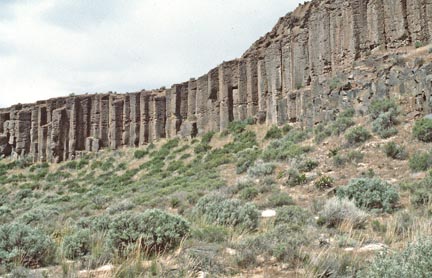
Igneous rocks are called extrusive when they cool and solidify above the surface. These rocks usually form from a volcano, so they are also called volcanic rocks. Extrusive igneous rocks cool much more rapidly than intrusive rocks. There is little time for crystals to form, so extrusive igneous rocks have tiny crystals. Cooling rate and gas content create a variety of rock textures. Lavas that cool extremely rapidly may have a glassy texture. Those with many holes from gas bubbles have a vesicular texture.
HUMAN USE OF IGNEOUS ROCK
Igneous rocks have a wide variety of uses. One important use is as stone for buildings and statues. Granite is used for both of these purposes and is popular for kitchen countertops. Pumice is commonly used as an abrasive. Pumice is used to smooth skin or scrape up grime around the house. When pumice is placed into giant washing machines with newly manufactured jeans and tumbled, the result is “stone-washed” jeans. Ground up pumice stone is sometimes added to toothpaste to act as an abrasive material to scrub teeth. Peridotite is sometimes mined for peridot, a type of olivine that is used in jewelry. Diorite was used extensively by ancient civilizations for vases and other decorative artwork and is still used for art today.
Sedimentary Rocks

Sandstone is one of the common types of sedimentary rocks that form from sediments. There are many other types. Sediments may include:
- fragments of other rocks that often have been worn down into small pieces, such as sand, silt, or clay.
- organic materials, or the remains of once-living organisms.
- chemical precipitates, which are materials that get left behind after the water evaporates from a solution.
Rocks at the surface undergo mechanical and chemical weathering. These physical and chemical processes break rock into smaller pieces. Physical weathering simply breaks the rocks apart. Chemical weathering dissolves the less stable minerals. These original elements of the minerals end up in solution and new minerals may form. Sediments are removed and transported by water, wind, ice, or gravity in a process called erosion.
Streams carry huge amounts of sediment. The more energy the water has, the larger the particle it can carry. A rushing river on a steep slope might be able to carry boulders. As this stream slows down, it no longer has the energy to carry large sediments and will drop them. A slower moving stream will only carry smaller particles.
Sediments are deposited on beaches and deserts, at the bottom of oceans, and in lakes, ponds, rivers, marshes, and swamps. Avalanches drop large piles of sediment. Glaciers leave large piles of sediments, too. Wind can only transport sand and smaller particles. The type of sediment that is deposited will determine the type of sedimentary rock that can form. Different colors of sedimentary rock are determined by the environment where they are deposited. Red rocks form where oxygen is present. Darker sediments form when the environment is oxygen poor.
SEDIMENTARY ROCK FORMATION
Accumulated sediments harden into rock by a process called lithification. Two important steps are needed for sediments to lithify.
-
- Sediments are squeezed together by the weight of overlying sediments on top of them. This is called compaction. Cemented, non-organic sediments become clastic rocks. If organic material is included, they are bioclastic rocks.
- Fluids fill in the spaces between the loose particles of sediment and crystallize to create a rock by cementation.
When sediments settle out of calmer water, they form horizontal layers. One layer is deposited first, and another layer is deposited on top of it. So each layer is younger than the layer beneath it. When the sediments harden, the layers are preserved. Sedimentary rocks formed by the crystallization of chemical precipitates are called chemical sedimentary rocks.
Biochemical sedimentary rocks form in the ocean or a salt lake. Living creatures remove ions, such as calcium, magnesium, and potassium, from the water to make shells or soft tissue. When the organism dies, it sinks to the ocean floor to become a biochemical sediment, which may then become compacted and cemented into solid rock.
HUMAN USE OF SEDIMENTARY ROCK
Sedimentary rocks are used as building stones, although they are not as hard as igneous or metamorphic rocks. Sedimentary rocks are used in construction. Sand and gravel are used to make concrete; they are also used in asphalt. Many economically valuable resources come from sedimentary rocks. Iron ore and aluminum are two examples.
Metamorphic Rock
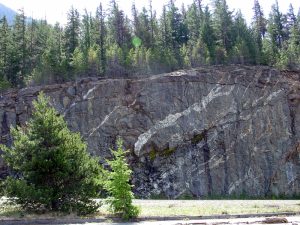
Metamorphism is the addition of heat and/or pressure to existing rocks, which causes them to change physically and/or chemically so that they become a new rock. Metamorphic rocks may change so much that they may not resemble the original rock. Any type of rock—igneous, sedimentary, or metamorphic—can become a metamorphic rock. All that is needed is enough heat and/or pressure to alter the existing rock’s physical or chemical makeup without melting the rock entirely. Rocks change during metamorphism because the minerals need to be stable under the new temperature and pressure conditions. The need for stability may cause the structure of minerals to rearrange and form new minerals. Ions may move between minerals to create minerals of different chemical composition. Hornfels, with its alternating bands of dark and light crystals, is a good example of how minerals rearrange themselves during metamorphism. Extreme pressure may also lead to foliation, the flat layers that form in rocks as the rocks are squeezed by pressure. Foliation normally forms when pressure is exerted in only one direction. Metamorphic rocks may also be non-foliated. Quartzite and limestone are nonfoliated. The two main types of metamorphism are both related to heat within Earth:
- Regional metamorphism: Changes in enormous quantities of rock over a wide area caused by the extreme pressure from overlying rock or from compression caused by geologic processes. Deep burial exposes the rock to high temperatures.
- Contact metamorphism: Changes in a rock that is in contact with magma because of the magma’s extreme heat.
Quartzite is very hard and is often crushed and used in building railroad tracks. Schist and slate are sometimes used as building and landscape materials. Graphite, the “lead” in pencils, is a mineral commonly found in metamorphic rocks.



